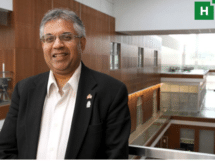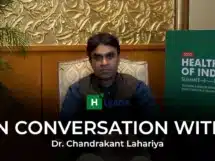As India strives to ramp up COVID vaccinations, Health Analytics Asia speaks to Dr. Chandrakant Lahariya, public policy and health systems expert. Dr. Lahariya has also authored the book “Till We Win: India’s fight against the COVID-19 Pandemic” with Dr. Gagandeep Kang and Dr. Randeep Guleria.
More than four months into the #LargestVaccinationDrive in India, a little over 40 million people have received both doses of COVID vaccine – this is under four per cent of the population.
With a devastating second wave on a slow but steady decline, India now looks to shift focus back on its COVID vaccinations. Health Analytics Asia spoke with public policy and health systems expert Dr. Chandrakant Lahariya, to understand the continuously changing COVID vaccine landscape in India, and what it means to the country’s 1.4 billion population.
During the interview, Dr. Lahariya paints a more pragmatic picture, with a reality check on the ambitious plans from the government.
India will not have the vaccines doses as projected
Commenting on Union Minister Prakash Javedkar’s claim that India would fully vaccinate the entire Indian population by December 2021, Dr. Lahariya enumerates the vaccines in the pipeline. “There are 120 million (doses) for June and 150 million for July. Put together, 270 million doses, over and above the 220 million already administered. By best estimates, the total by the end of July would be 490 million shots administered.” He further asserts, “The original target was to vaccinate 300 million people, or administer 600 million shots (by August 2021). India is not going to achieve the original target.”
Dr. Lahariya says that the government’s goal, although ambitious, is based on the availability projections of vaccines that are still in trials. He further adds that the experience so far vis à vis supply and scaling up of vaccine production has not been good enough to be so optimistic about in-trial vaccines. “We have seen that while they are ambitious in projecting their production capacity, scaling up is not entirely in the hands of vaccine manufacturers, as it depends on other factors such as supply of raw materials.”
Dr. Lahariya points out that even if vaccine doses are available, fully vaccinating the entire population this year would mean that everyone gets at least one shot well before the end of 2021 – by September, so that their second dose also happens in 2021. “India will not be able to vaccinate fully till early 2022. That is a realistic estimate. In my opinion, India will not have the kind of vaccine doses (supply) as projected.”
“Availability is not delivery,” remarks Dr. Lahariya, stressing on the need to plan the distribution and administering of the doses.
Responding to claims made by the Director-General of the Indian Council of Medical Research Dr. Balram Bhargav, that India will receive 10 million shots per day, Dr. Lahariya says, “To maintain an average of 10 million doses a day, you need an assured supply of 300 million doses for that month. Vaccine availability for July is around 150 million shots. Even August and September do not have that scale of availability.” He further adds that this kind of supply will not be achieved before late-September or early October.
Scampering race to buy vaccines
Vaccine procurement and availability has become a limiting point in India’s vaccination drive, as daily vaccination numbers remain well below the rate needed. India’s “Liberalised Pricing and Accelerated National Covid-19 Vaccination Strategy” puts partial onus of buying vaccine doses on the states. This has led to individual states floating global tenders, with many, including Delhi, claiming that manufacturers are not entertaining their requests.
On being asked about how it is shaping into a Centre-vs-state tussle, Dr. Lahariya is critical of this contentious policy, “What is the purpose behind the liberalized vaccine policy where there are differential rates, and states are expected to purchase? Short term or long term, delegating or expecting states to purchase vaccines directly from the manufacturers is not a good strategy especially in a pandemic.”
“The procurement and supply division is one of the weakest departments in state governments,” he says, highlighting the states’ inexperience, and how universal immunization has always been the liability of the centre. “The responsibility of purchasing vaccines is with the central government, and the responsibility of delivering vaccines is with the state government.”
India’s states are economies that vary from a per capita Net Domestic Product of $600 to over $6000. Commenting on the competition created by this policy, Dr. Lahariya says, “States will have to compete with each other to secure the limited vaccines, and in the process they would end up paying a far higher price.”
“It (liberalized pricing policy) is resulting in inequity. Richer states are more likely to buy vaccines,” Dr. Lahariya says, “while states are scrambling for vaccines, the private sector has all the vaccines they require, which essentially means they’re sold at far higher cost.”
India should have done more
India’s Finance Minister Nirmala Sitharaman, in November 2020, announced a grant of $120 million for COVID vaccine research. This came at a time when many of the leading vaccine candidates were nearing approvals, and countries such as the US and UK were preparing deployments as well. Dr. Lahariya opines that India fell behind in vaccine development. “That’s one area India definitely could have done more,” he said. “Government institutions have an important role in health R&D, be it vaccines or medicines. Investing in R&D is an integral part of the strategy which the government should follow.”
Recalling India’s existing public and private sector vaccine industries, Dr. Lahariya says, “India closed down some of the public sector units 2008 onwards. The kind of consideration given (now) to revive and utilise public sector units to produce vaccines, should have started last year in October and November.”
“We develop on R&D to build future capacity. Had we taken this step earlier, India would have been better positioned now.”
Is a third wave a possibility or is it just speculation?
As the devastating second wave recedes across the country, there is talk of a looming third wave as well, with many speculating that it will hit children more. On the science behind these claims, Dr. Lahariya was quick to point out that the virus’ behaviour is not age-differentiated.
“There is a real risk of a third wave. We cannot predict when it will happen. It depends on how India can scale up its vaccinations, on the kind of mutations that can happen in the virus and how it changes in pathogenicity, infecticitiy, and transmissibility.” Dr Lahariya, however, places an estimate based on the disease’s epidemiology, “We know that after natural infection, a person is protected for six to nine months. It can be said that a third wave could be seen somewhere around November 2021 to early 2022.
“Children do not develop severe disease because they do not have a particular receptor to which the SARS-CoV-2 latches to infect the lungs. I don’t see any epidemiological evidence, or data, or change in virus behaviour that would indicate that in the third wave, children will be more infected.”
Dr. Lahariya also refers to the nationwide serosurvey prior to the second wave that indicated 22 per cent of Indian population to be COVID infected. “India entered into the second wave with 78 per cent of its population still susceptible,” he says, “with the kind of infection ongoing, it can be estimated that 50-60 per cent of the population will have developed either asymptomatic or symptomatic COVID-19. which essentially means the pool of susceptible population for any future wave would be half of what it was a few months ago.”


















Add Comment